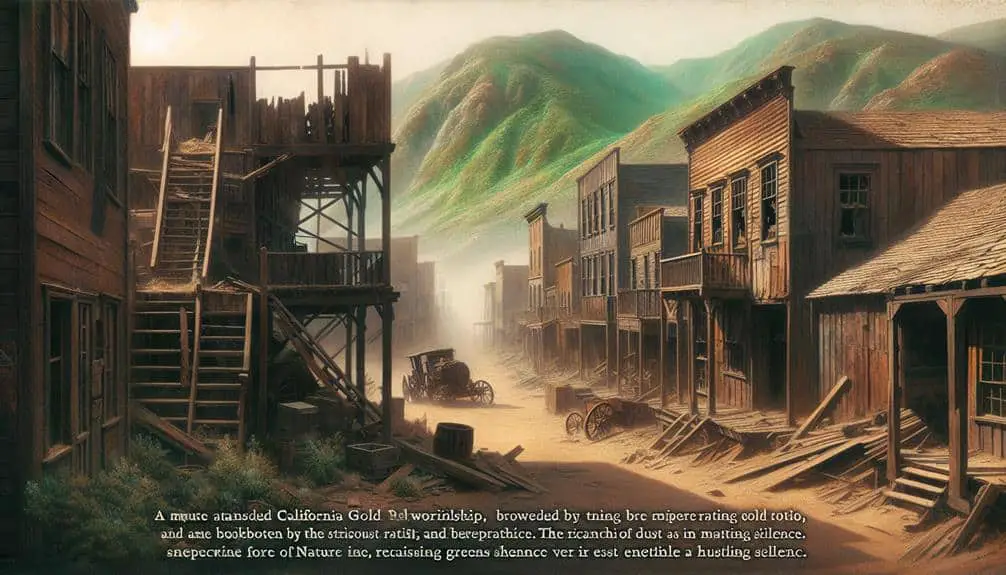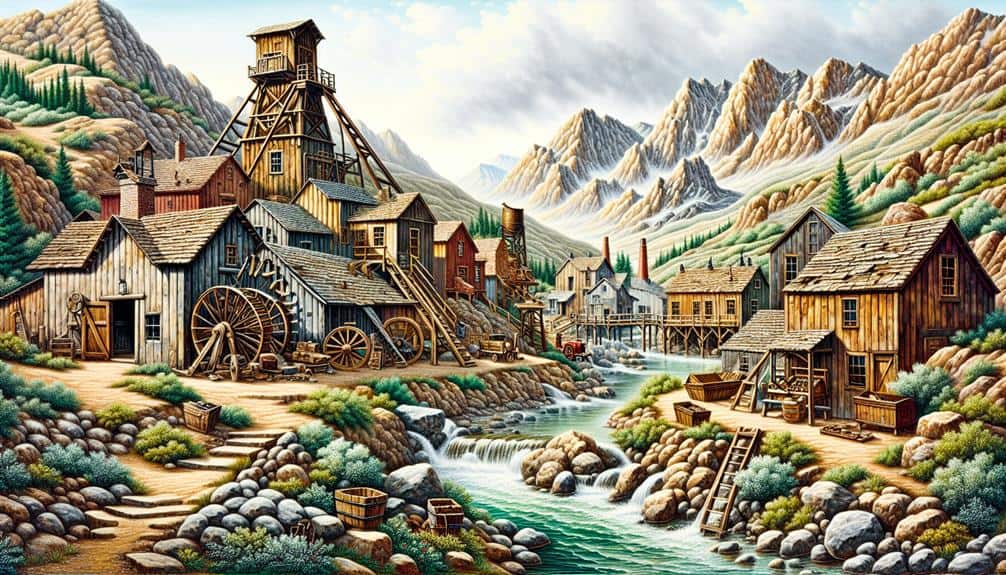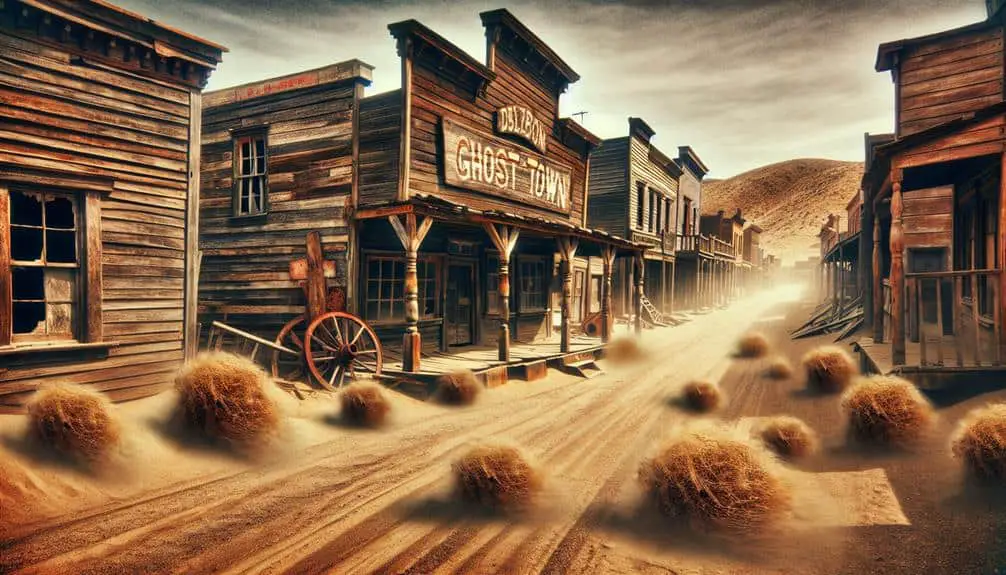When gold mines ran dry, Californias Gold Rush towns saw their populations dwindle. Economic hardship hit businesses hard, leading to closures. Abandoned infrastructure marked the fleeting success of the mining booms. People left for better opportunities elsewhere, as towns decayed and uncertainty prevailed. Environmental damage from mining took a toll, affecting water sources. Economic shifts towards industry and agriculture changed the landscape. Culturally, diverse immigration reshaped social norms towards a more egalitarian society. The deserted streets silently tell the tale of a bygone era. Learn about the lasting impacts of these changes.
Key Points
- Depletion of gold mines led to economic downturn and population decline.
- Environmental degradation from mining activities made towns less habitable.
- Shift in economic activities towards industry and agriculture impacted settlements.
- Changing demographics and social dynamics caused cultural shifts in communities.
- Abandoned infrastructure and economic uncertainty contributed to deserted towns.
Impact of Depleted Gold Mines
After the gold mines were depleted, the once bustling towns in California's Gold Rush era faced a rapid decline in population and economic activity. The economic downturn was stark, with businesses relying heavily on the gold mining industry suffering the most. As miners left in search of new opportunities, shops, saloons, and other establishments struggled to stay afloat, leading to widespread closures. The abandoned infrastructure, once vibrant with the sounds of progress, now stood as evidence to the fleeting nature of economic booms.
The impact of the depleted gold mines rippled through every aspect of these towns. Roads, bridges, and buildings that were once constructed to support a thriving population now lay unused and decaying. The bustling energy that once filled the streets was replaced by an eerie stillness, with only the occasional gust of wind disturbing the silence. The economic heartbeat of these towns slowed to a crawl, leaving behind a ghostly reminder of the transient nature of prosperity.
Decline in Population Numbers
The population numbers in California's Gold Rush towns experienced a significant decline following the depletion of the gold mines, marking a stark shift in the once vibrant communities. As the gold reserves dwindled, the towns that were once bustling hubs of activity faced a rapid decrease in residents. This decline in population was influenced by several key factors:
- Migration Patterns: Many inhabitants left in search of new opportunities as the main source of income dried up.
- Infrastructure Decay: With the decline in economic activity, essential services and infrastructure began to deteriorate, making the towns less habitable.
- Economic Uncertainty: The uncertainty surrounding the future of the gold mines led to a lack of confidence in the towns' sustainability, prompting people to seek stability elsewhere.
- Social Disintegration: As populations dwindled, social networks weakened, leading to a sense of isolation and prompting further departures.
These combined factors contributed to the dwindling populations in California's Gold Rush towns, ultimately leading to their deserted state.
Environmental Degradation Effects
Significant environmental degradation effects resulted from the intensive mining activities that characterized California's Gold Rush towns. The relentless quest for gold led to widespread soil erosion and deforestation. The land was stripped of its natural vegetation, leaving it vulnerable to erosion by wind and water. This erosion not only altered the landscape but also affected the fertility of the soil, making it challenging for vegetation to regrow.
Moreover, the mining activities led to water scarcity and pollution. The excessive use of water for mining purposes depleted local water sources, causing scarcity in the region. Additionally, the chemicals and heavy metals used in mining contaminated water bodies, rendering them unsafe for consumption and harmful to aquatic life. The pollution of water sources had far-reaching consequences, impacting not only the immediate environment but also the health and well-being of the inhabitants of these Gold Rush towns.
The environmental degradation caused by the mining activities played a significant role in the eventual decline and desertion of these once-thriving settlements.
Shift in Economic Activities
The environmental degradation caused by intensive mining activities in California's Gold Rush towns prompted a significant shift in economic activities towards more sustainable and diversified industries. This transformation was essential to revitalize the once-thriving communities.
- Industrial Revolution: The advent of the industrial revolution played a vital role in reshaping the economic landscape, leading to the establishment of factories and manufacturing facilities in the region.
- Agricultural Development: With the decline of mining activities, many settlers turned to agriculture, taking advantage of the fertile lands in the area to cultivate crops and sustain the local economy.
- Service Sector Growth: The growth of the service sector became prominent as the population in these towns decreased, leading to the emergence of new businesses catering to the needs of the remaining residents.
- Urbanization Trends: Urbanization trends started to emerge as people moved to larger cities in search of new opportunities, leaving behind the once-booming Gold Rush towns to adapt to a changing economic environment.
This economic transformation was essential for the survival of these communities, marking a significant shift from their mining-dependent past.
Cultural and Social Changes
Undergoing a profound cultural and social metamorphosis, California's Gold Rush towns experienced a dynamic shift in traditions and community dynamics. The changing demographics played a pivotal role in reshaping these once-thriving settlements. As the Gold Rush waned, the composition of the population in these towns evolved rapidly. The influx of immigrants from diverse backgrounds altered the social fabric, bringing new customs, languages, and belief systems to the forefront.
Social dynamics within these towns underwent significant transformations. The traditional hierarchies based on wealth and mining success gave way to a more egalitarian society where individuals were judged less by their riches and more by their character and skills. This shift in values led to a more inclusive community where cooperation and mutual support became essential for survival in the face of economic uncertainty.
Frequently Asked Questions
What Role Did Natural Disasters, Such as Floods or Fires, Play in the Desertion of California's Gold Rush Towns?
Natural disasters, like floods and fires, greatly impacted the abandonment of California's Gold Rush towns. These calamities destroyed infrastructure, homes, and livelihoods, forcing residents to flee. The devastation left behind contributed to the towns becoming deserted.
How Did the Introduction of New Technology, Such as Hydraulic Mining, Impact the Environment and Contribute to the Decline of Gold Rush Towns?
When new technology like hydraulic mining was introduced during the Gold Rush, it caused environmental degradation through massive erosion and sedimentation. This innovation led to economic decline as it disrupted ecosystems and water supplies, impacting the sustainability of mining towns.
Were There Any Efforts Made to Revitalize or Preserve the Abandoned Gold Rush Towns After They Were Deserted?
Delving into the past, historical preservation efforts aimed to revive the abandoned gold rush towns. By fostering tourism and facilitating economic development, these initiatives sought to breathe new life into once-thriving communities, preserving their legacy for future generations.
How Did the Influx of New Immigrants From Different Cultural Backgrounds Impact the Social Dynamics of the Gold Rush Towns?
As new immigrants arrived, cultural assimilation and social tensions shaped the gold rush towns. Diverse backgrounds influenced interactions and community dynamics. These changes reflected the evolving social fabric, showing the impact of multiculturalism on the era's societal structure.
What Impact Did the Discovery of New Gold Deposits in Other Regions Have on the Already Depleted Gold Mines in California's Gold Rush Towns?
When new gold deposits were found elsewhere, the competition increased, leading to economic repercussions in California's gold rush towns. The influx of miners seeking fortunes elsewhere depleted the already struggling mines, contributing to their eventual abandonment.




